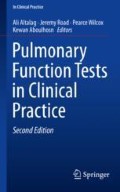Abstract
This chapter provides a structured approach to analyzing and interpreting the many data points necessary to provide an accurate assessment of normal and abnormal pulmonary function tests. Spirometry provides the foundation of all PFT assessments followed by lung volume and gas transfer interpretation. By the end of this chapter we hope to provide a reproducible and reliable framework for PFT interpretation.
Access this chapter
Tax calculation will be finalised at checkout
Purchases are for personal use only
References
Miller MR, Hankinson J, Brusasco V, et al. Standardisation of spirometry. Eur Respir J. 2005;26:319–38.
American Thoracic Society. Standardization of spirometry update. Am J Respir Crit Care Med. 1995;152:1107–36.
Dykstra BJ, Scanlon PD, Kester MM, Beck KC, Enright PL. Lung volumes in 4,774 patients with obstructive lung disease. Chest. 1999;115:68–74.
Aaron SD, Dales RE, Cardinal P. How accurate is spirometry at predicting restrictive pulmonary impairment? Chest. 1999;115:869–73.
Glady CA, Aaron SD, Lunau M, Clinch J, Dales RE. A spirometry-based algorithm to direct lung function testing in the pulmonary function laboratory. Chest. 2003;123:1939–46.
Pellegrino R, Viegi G, Brusasco V, et al. Interpretative strategies for lung function tests. Eur Respir J. 2005;26:948–68.
Cerveri I, Pellegrino R, Dore R, Corsico A, Fulgoni P, van de Woestijne KP, Brusasco V. Mechanisms for isolated volume response to a bronchodilator in patients with COPD. J Appl Physiol. 2000;88:1989–95.
Flenley DC. Chronic obstructive pulmonary disease. Dis Mon. 1988;34:537–99.
MacIntyre N, Crapo RO, Viegi G, et al. Standardisation of the single-breath determination of carbon monoxide uptake in the lung. Eur Respir J. 2005;26:720–35.
Viegi G, Baldi S, Begliomini E, Ferdeghini EM, Pistelli F. Single breath diffusing capacity for carbon monoxide: effects of adjustment for inspired volume dead space, carbon dioxide, hemoglobin and carboxyhemoglobin. Respiration. 1998;65:56–62.
Mohsenifar Z, Brown HV, Schnitzer B, Prause JA, Koerner SK. The effect of abnormal levels of hematocrit on the single breath diffusing capacity. Lung. 1982;160:325–30.
Clark EH, Woods RL, Hughes JM. Effect of blood transfusion on the carbon monoxide transfer factor of the lung in man. Clin Sci Mol Med. 1978;54:627–31.
Cotes JE, Dabbs JM, Elwood PC, Hall AM, McDonald A, Saunders MJ. Iron-deficiency anaemia: its effect on transfer factor for the lung (diffusiong capacity) and ventilation and cardiac frequency during sub-maximal exercise. Clin Sci. 1972;42:325–35.
Marrades RM, Diaz O, Roca J, Campistol JM, Torregrosa JV, Barberà JA, Cobos A, Félez MA, Rodriguez-Roisin R. Adjustment of DLCO for hemoglobin concentration. Am J Respir Crit Care Med. 1997;155:236–41.
Hancox B, Whyte K. Bob pocket guide to lung function tests. 1st ed. Sydney: McGraw-Hill; 2001.
Pride NB, Macklem PT. Lung mechanics in disease. In: Macklem PT, Mead J, editors. Handbook of physiology. The respiratory system. Mechanics of breathing. Section 3, vol. 3, Part 2. Bethesda, MD: American Physiological Society; 1986. p. 659–92.
Henderson JC, O’Connell F, Fuller RW. Decrease of histamine induced bronchoconstriction by caffeine in mild asthma. Thorax. 1993;48:824–6.
Cotton DJ, Prabhu MB, Mink JT, Graham BL. Effects of ventilation inhomogeneity on DLcoSB-3EQ in normal subjects. J Appl Physiol. 1992;73:2623–30.
Cotton DJ, Prabhu MB, Mink JT, Graham BL. Effect of ventilation inhomogeneity on “intrabreath” measurements of diffusing capacity in normal subjects. J Appl Physiol. 1993;75:927–32.
Gelb AF, Gold WM, Wright RR, Bruch HR, Nadel JA. Physiologic diagnosis of subclinical emphysema. Am Rev Respir Dis. 1973;107:50–63.
Morrison NJ, Abboud RT, Ramadan F, Miller RR, Gibson NN, Evans KG, Nelems B, Müller NL. Comparison of single breath carbon monoxide diffusing capacity and pressure-volume curves in detecting emphysema. Am Rev Respir Dis. 1989;139:1179–87.
Hyatt RE, Scanlon PD, Nakamura M. Interpretation of pulmonary function tests, a practical guide. 2nd ed. Philadelphia, PA: Lippincott Williams & Wilkins; 2003.
Malcolm ATS, Gary C. Respiratory muscle testing: tests of respiratory muscle strength. Am J Respir Crit Care Med. 2002;166:518–624.
Green M. Respiratory muscle testing. Bull Eur Physiopathol Respir. 1984;20:433–5.
Salzman J. Pulmonary function testing. Tips on how to interpret the results. J Respir Dis. 1999;20:809–22.
Gilbert R, Auchincloss JH. What is a “restrictive” defect? Arch Intern Med. 1986;146:1779–81.
Author information
Authors and Affiliations
Corresponding author
Editor information
Editors and Affiliations
Rights and permissions
Copyright information
© 2019 Springer International Publishing AG, part of Springer Nature
About this chapter
Cite this chapter
Altalag, A., Road, J., Wilcox, P., Aboulhosn, K. (2019). Approach to PFT Interpretation. In: Altalag, A., Road, J., Wilcox, P., Aboulhosn, K. (eds) Pulmonary Function Tests in Clinical Practice. In Clinical Practice. Springer, Cham. https://doi.org/10.1007/978-3-319-93650-5_6
Download citation
DOI: https://doi.org/10.1007/978-3-319-93650-5_6
Published:
Publisher Name: Springer, Cham
Print ISBN: 978-3-319-93649-9
Online ISBN: 978-3-319-93650-5
eBook Packages: MedicineMedicine (R0)

